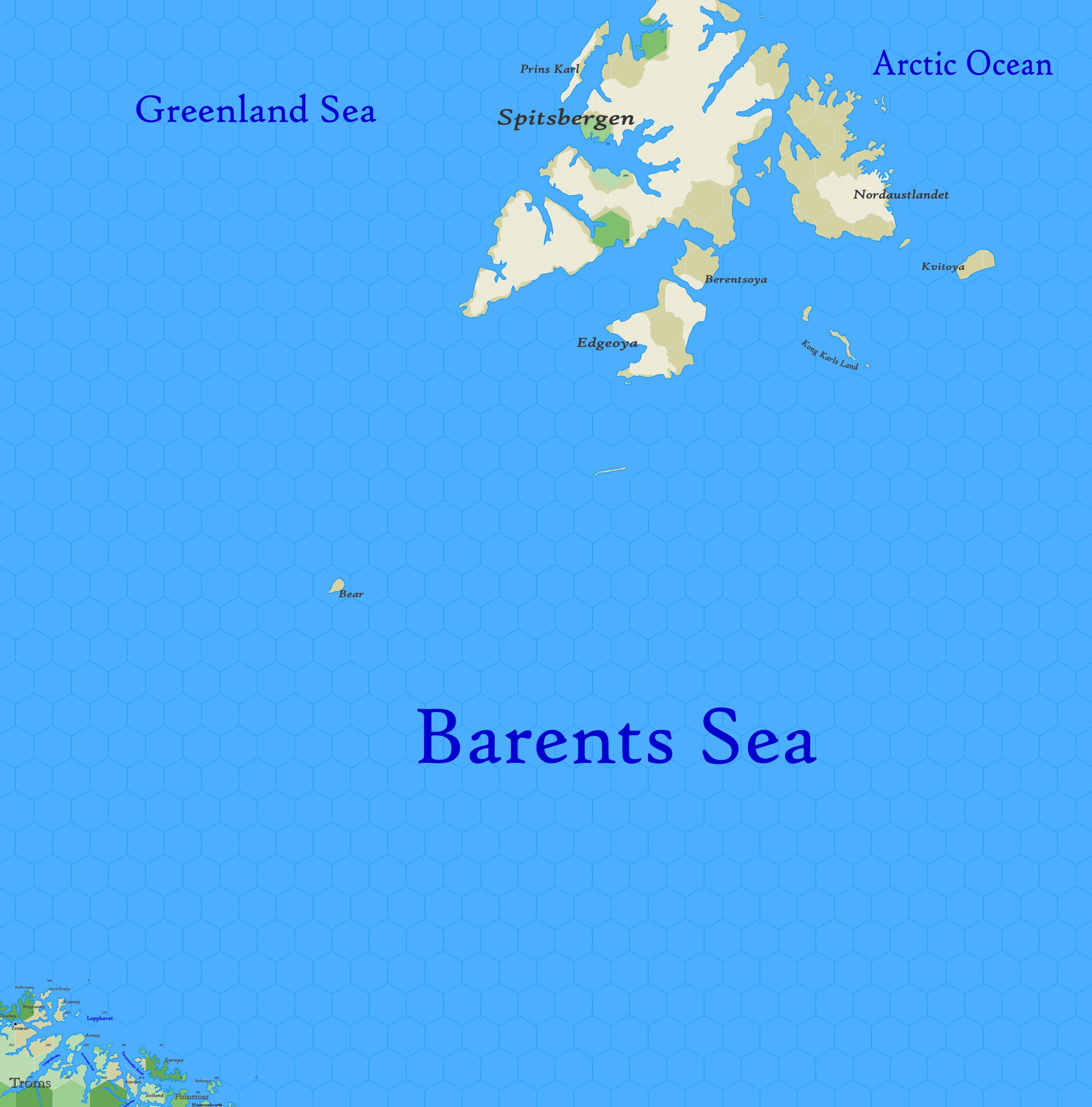Map A.02 - East Spitsbergen
Arctic region reaching south from 82.34°N south to 72.51°N, covering the Barents Sea between Spitsbergen and the rugged coasts of Troms and Finnemar, depicted in the bottom left. These frigid waters are frequented annually by whaling vessels, whose crews ominously refer to the Barents Sea as "the Devil's Dance Floor."
Hexes are 20 miles in diameter. Total area depicted equals 366,450 sq.m.
Features
Barents Sea
A vast and restless expanse of the Arctic Ocean, stretching eastward from the Greenland Sea and bordered by Spitsbergen, Franz Josef Land, Jotunheim and the northernmost reaches of Scandinavia and Russia. Named after Willem Barents, the Dutch navigator who charted its waters in the 16th century while seeking the Northeast Passage to China, it remains a perilous and unpredictable maritime region, known for its strong currents, seasonal ice cover and unpredictable storms.
Spanning 940 miles from east to west, much of the Barents Sea is shallow, with depths of less than 100 fathoms in many places. This shallow seabed contributes to complex eddies and shifting currents, making navigation treacherous without the guidance of an experienced navigator. The North Atlantic Drift, a continuation of the Gulf Stream, flows into the sea near Spitsbergen, carrying relatively warm waters that prevent permanent ice formation in the southwestern region. This warming effect also moderates air temperatures, ensuring that the portion closest to Europe remains navigable year-round, providing access to the port of Westia in Ulthua, even during the depths of winter.
Despite this warming influence, the Barents remains an Arctic sea, with seasonal ice cover advancing from the northeast, reaching its maximum extent in April, when nearly four-fifths of the sea is frozen over. By summer, melting ice recedes, but icebergs remain a constant hazard, especially in the north and east. Water temperatures fluctuate yearly, with the coldest conditions in April and the warmest in October, though even at their peak, temperatures rarely rise above freezing in the northernmost regions.
The rich fisheries of the Barents Sea support abundant populations of haddock, cod and plaice, with large-scale fishing taking place along the southern banks. The northern reaches, however, are desolate, patrolled only by ice, fog and the occasional whaling vessel daring to venture into the region's frigid depths. The sea's turbulent nature has earned it the name "the Devil's Dance Floor" among sailors, a grim testament to the unpredictable weather, rogue waves and deadly ice flows that make every voyage a risk.
One of the few notable landmasses within the Barents Sea is Bear Island, first recorded by Willem Barents in 1596 when his crew encountered and killed a polar bear there. In 1603, English explorer Stephen Bennet attempted to rename it Cherrie Island, a name which persists on some charts, though sailors and traders continue to favour its original title. The island is largely barren and windswept, with rocky plains and scant Arctic vegetation. Its eastern coast is distinguished by three pyramid-like peaks, rising over 1,500 feet into the frigid air, while its southern cliffs plunge steeply into the sea, dotted with towering rock pillars formed by centuries of relentless erosion. During the nesting season, the cliffs are alive with thousands of waterfowl, whose cries echo over the icy waves.
Spitsbergen
An unexplored archipelago in the far northern reaches of the world, Spitsbergen consists of five major islands and an untold number of smaller ones, stretching roughly 250 miles from east to west. The northernmost extent of the land has never been observed, remaining shrouded in ice and mystery. The land is rugged and broken, dominated by jagged mountain peaks that rise sharply above the frigid landscape — these "spits bergen," or "pointed mountains", reach elevations of more than 5,000 feet, their snow-covered summits visible from great distances.
The larger islands are draped in massive glaciers, sheets of ice so immense that they extend down into the sea, where they calve icebergs into the frigid waters. The coastline is deeply indented by fjords, some stretching many miles inland, their waters cold and dark, carved by the slow march of the ice over centuries untold. During the brief summer months, when the snow at lower elevations — up to 1,600 feet — melts away, rivers form and rush toward the fjords, but these waterways are short-lived and of little importance. Most precipitation that falls upon the islands never becomes liquid water but instead returns to the sea as glacial ice, ever feeding the frozen rivers of the land.
Vegetation is sparse and hardy, consisting almost entirely of tundra flora. Mosses, lichens and small flowering plants cling to the rocky soil, thriving in sheltered pockets where the ice does not fully consume the land. A few dwarf trees, stunted by the severe cold and poor soil, can be found in protected valleys. The climate is wholly arctic, with brisk summers that allow for a fleeting season of growth before the land once again succumbs to the grip of winter.
Though known to the Norse since 1194 A.D., Spitsbergen was rediscovered by the Dutch navigator Willem Barents in 1596. Since then, it has become a yearly destination for whalers and sealers, who navigate the treacherous waters in pursuit of the great creatures that roam the ice-clad seas. The land is home to walruses, polar bears, reindeer and arctic foxes, creatures well-adapted to the harsh and unforgiving cold. The skies above the fjords and coastal cliffs are filled with the cries of various seabirds, including eider ducks, ptarmigans, gulls and the silent, watchful snowy owl.
Little is known about whether Spitsbergen harbours any true inhabitants — the whalers and traders who return from its shores speak only of endless ice, towering peaks and a land untouched by time.
Adjacent Maps
| A1: Greenland Sea | A2: East Spitsbergen | A3: Jotunheim |
|---|---|---|
| B1: Lofoten | B2: Lapland | B3: Yak'Margug |
See Sheet Maps

